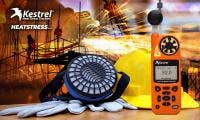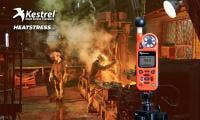The Vital Role of Heat Stress Monitoring in Occupational Health and Safety

Protecting employees from heat stress has become a critical issue for many industries, especially those involving outdoor or high-temperature environments like construction, agriculture, and manufacturing. Heat stress monitoring allows organizations to take proactive steps to ensure worker safety, health, and productivity, especially during peak heat periods.
Why Heat Stress Monitoring Matters
Heat stress occurs when the body is unable to cool itself effectively, leading to conditions that can range from discomfort to severe illnesses like heat exhaustion and heat stroke. Monitoring heat stress in real-time enables safety managers to act fast and make informed decisions, minimizing risks to worker health.
By measuring environmental factors such as temperature, humidity, and radiant heat, heat stress monitors provide accurate data that helps in:
- Preventing Heat-Related Illnesses: Access to real-time data helps adjust work schedules and implement safety measures, reducing instances of heat-related health issues.
- Ensuring Regulatory Compliance: Adhering to safety guidelines on heat exposure not only protects employees but also reduces the risk of fines and legal liabilities.
- Increasing Productivity: A well-monitored environment leads to fewer incidents, which means employees can work effectively, enhancing overall productivity.
To view signs and symptoms of heat stress, click here.
How Heat Stress Monitoring Works

Heat stress monitors come in portable and fixed models and use sensors to measure critical factors affecting heat stress. Some monitors calculate the Wet Bulb Globe Temperature (WBGT), which is highly effective for determining heat risk by accounting for the air temperature, wet bulb globe temperature, and black globe temperature. The collected data can trigger alerts to prompt hydration, breaks, or other preventive actions, helping to protect workers from overheating.
Industries That Benefit from Heat Stress Monitoring

While every workplace can benefit from monitoring, certain industries face higher risks and can see immediate advantages:
- Construction and Agriculture: Outdoor workers are often exposed to extreme heat, making regular monitoring essential for safety.
- Manufacturing and Warehousing: Indoor heat from machinery and limited ventilation make heat stress monitoring a critical safety measure.
Implementing Heat Stress Monitoring for a Safer Workplace
Creating an effective heat stress monitoring program doesn’t have to be complex. Focus on:
- Training Employees: Educate workers on heat stress symptoms, hydration, and the importance of breaks.
- Using Reliable Monitoring Tools: Select monitors suitable for your industry that offer real-time alerts.
- Establishing Safety Protocols: Develop response actions for high-heat conditions, such as increased hydration or adjusted work shifts.
Heat stress monitoring is not just about compliance - it’s about safeguarding the well-being of those who keep businesses moving forward. With the right tools and protocols, organizations can create a safer, healthier workplace that supports both productivity and employee welfare.





